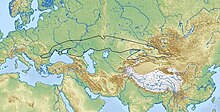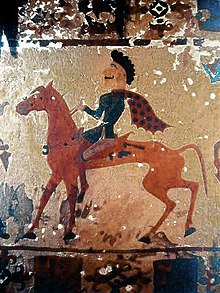Scytho-Siberian world
 | |
| Geographical range | Eurasian Steppe |
|---|---|
| Period | Iron Age |
| Dates | c. 900 BC–200 AD |
| Preceded by | Srubnaya culture, Andronovo culture |
| Followed by | Goths, Alans, Xiongnu, Circassians |
The Scytho-Siberian world
The Scythian-Siberian world was characterized by the Scythian triad, which are similar, yet not identical, styles of weapons, horses' bridles, and
Origins and spread

The Scytho-Siberian world emerged on the Eurasian Steppe at the dawn of the Iron Age in the early 1st millennium BC. Its origins has long been a source of debate among archaeologists.[4] The Pontic–Caspian steppe was initially thought to have been their place of origin, until the Soviet archaeologist Aleksey Terenozhkin suggested a Central Asian origin.[5][6]
Recent excavations at
The Scytho-Siberian world quickly came to stretch from the
Recent archeological and genetic data confirmed that Western and Eastern Scythians of the 1st millennium BC originated independently, but both formed from a combination of a
Peoples

Ethnicity
The peoples of the Scytho-Siberian world are mentioned by contemporary
Despite belonging to similar material cultures, the peoples of the Scytho-Siberian world belonged to many separate ethnic groups.[16][17] Peoples associated with the Scytho-Siberian world include speakers of the Scythian languages:[5][18]- Massagetae[5]
- Sarmatians[5]
- Saka[5]
- Scythians[5]
- Agathyrsi[19]
- Sigynnae[19]
- Cimmerians[18]
- Forest steppe people[18]
Although the peoples of the forest steppe were part of the Scytho-Siberian world, their origins are obscure;
Terminology

Among the diverse peoples of the Scytho-Siberian world, the Scythians are the most famous, due to the reports on them published by the 5th century Greek historian Herodotus. The ancient Persians referred to all nomads of steppe as Saka. In modern times, the term Scythians is sometimes applied to all the peoples associated with the Scytho-Siberian world.[20] Within this terminology it is often distinguished between "western" Scythians living on the Pontic–Caspian steppe, and "eastern" Scythians living on the Eastern Steppe.[5][13] The term Scytho-Siberians has also been applied to all peoples associated with the Scytho-Siberian world.[25] The terms Early Nomads[26] and Iron Age Nomads have also been used.[10] The terms Saka or Sauromates, and Scytho-Siberians, is sometimes used for the "eastern" Scythians living in Central Asia and southern Siberia respectively.[9][27]
The ambiguity of the term Scythian has led to a lot of confusion in literature.[c][18]
Nicola Di Cosmo (1999) questions the validity of referring to the cultures of all early Eurasian nomads as "Scythian", and recommends the use of alternative terms such as Early Nomadic.[29][d]
By ancient authors, the term "Scythian" eventually came to be applied to a wide range of peoples "who had no relation whatever to the original Scythians", such as Huns, Goths, Turks, Avars, Khazars, and other unnamed nomads.[13]
Characteristics
The cultures of the Scytho-Siberian world are recognized for three characteristics known as the Scythian triad:[18][27]
- similar, yet not identical, shapes for horses' bridles,
- their weapons, especially their distinct short, composite bows, and
- the styling on their jewelry and decorations.
Their art was made in the
Finds
In the beginning of the 18th century, Russian explorers began uncovering Scythian finds throughout their newly acquired territories.
Significant Scythian archaeological finds have been uncovered up to recent times. A major find are the
Society
The Scythians were excellent craftsmen with complex cultural traditions.
Numerous archaeological finds have revealed that the Scythians led a warlike life: Their competition for territory must have been fierce. The numerous weapons placed in graves are indicative of a highly militarized society. Scythian warfare was primarily conducted through
Physical appearance
The Scythians were tall and powerfully built, even by modern standards.
Their physical traits are characteristic of
Numerous Eastern Scythian remains have been found in an excellent state of preservation in the
Preserved skin tissue also reveals that the eastern Scythians had tattoos. Tattooing is not thought to have been practiced by western Scythians.[36]
Genetics
The genetics of remains from Scythian-identified cultures show broad general patterns, among these are remarkably different histories for men and women. Their ethnic affiliations are summarized above. Their familial inter-relations are discussed below.
There are two distinct paternal lineages in the east and west,
The maternal lineages among Scythians are diverse,[5][10][27] showing a mixture of Eastern and West Eurasian lineages, with increasing East Asian admixture in the Iron Age.[9][40] In Western Scythians, West Eurasian maternal lineages are 62.5-74% of the total, while East Eurasian maternal lineages are 26-37%.[9] In a sample of Eastern Scythians from Tuva, the maternal lineages are nearly equally divided between Western and East Eurasian sources.[27]

